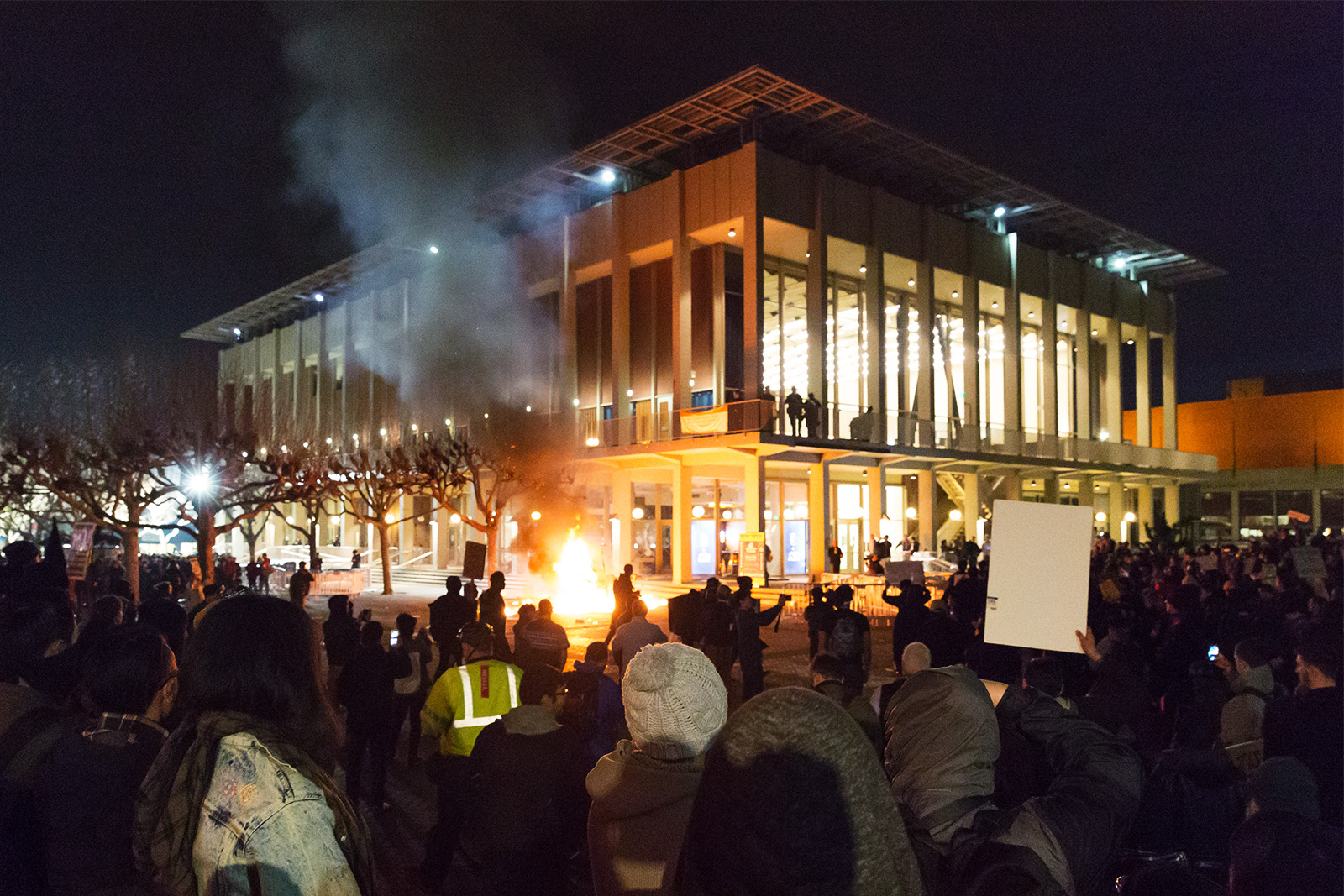Clea Wurster: Student protests must outline clear purpose in order to be effective

Protests against conservative provocateur Milo Yiannopoulos turned violent Wednesday at UC Berkeley. The violence has since been blamed on outside groups. (Daniel Kim/The Daily Californian)
By Clea Wurster
Feb. 5, 2017 9:37 p.m.
“Violent” is the buzzword used to describe left-leaning protesters who speak out against President Donald Trump and those like him. On Wednesday, UC Berkeley protesters epitomized the failures of the student left’s response to the harmful rhetoric employed by conservatives.
UC Berkeley students held a peaceful demonstration to protest Milo Yiannopoulos’ event, but violence ensued when individuals dressed in black – not affiliated with the student-led protest – set fires and threw objects.
This failure of peaceful demonstration exemplifies how we students are failing to generate change with our discontent. While its intentions may have been good, the Berkeley protest’s attempt fell short: Student protesters did not communicate goals or publicly introduce arguments. Worst of all, the conservative media can now easily cast aside student movements as “violent.”
While UCLA has not had violent protests on campus in response to the new administration, we must learn from Berkeley students and preempt potential violence at future demonstrations.
Luckily, we students are able to use campus resources to hold meetings and draft statements, collaborate with administration to organize protests and hold workshops on effectively protesting to generate genuine sociopolitical change. UCLA is teeming with political scientists, well-practiced organizers and administration willing to assist us in our efforts, all of whom we should take advantage of in order to maximize our impact.
Historically, movements that organize have been much more successful. Students in the 1960s and 1970s organized against many causes and called themselves the Students for a Democratic Society. SDS released a mission statement called the Port Huron Statement, which outlined its goals and values, giving it a working guide to conduct its demonstrations, and resulted in widespread public attention that helped the group gain numbers and recognition.
More recently, the Women’s March not only released a mission statement, but also guiding principles to lay out a concrete set of objectives it wanted the protest to achieve. The mainstream media picked up its statements, galvanizing marchers behind a well-defined goal, much like SDS’s statement.
Critics are claiming students stand in opposition to free speech, but that is not the case. The organization that planned the demonstration, Berkeley Against Trump, created a Facebook event and included a statement: “We are not here to engage in physical confrontation or violence with the police, nor the far-right/neo-Nazi groups,” but did not publicize their views effectively. Only 1,000 students signed up for the supposedly UC-wide event, and prior media coverage of the protests’ intentions was scant. Thus, it was easy for criticizers to ignore their intentions.
Had the organizers released a more comprehensive statement via social media regarding their beliefs and issues with Yiannopoulos, as well as their intentions for the demonstration’s intended societal result, they could have more convincingly made the case that any violence stemmed from outsiders taking advantage of the event. While they made it clear they do not tolerate Yiannopoulos’ “hate speech,” they did not provide a manner of addressing it aside from rejecting his presence on campus.
This disorganization is indicative of a larger problem apparent in anti-Trump protests. The coalition against Trump appears to exist solely to oppose Trump and presents itself as an opposition to the presidency rather than a group looking for an alternative. Mere rejection is not enough – students need to define what they want to accomplish within a widely released mission statement that explains their intents and justification for their participation in events such as the protest at UC Berkeley.
When an organized movement fails to distance itself from the violent few, it’s easier for the opposition to dismiss. For example, conservative commentator Tomi Lahren now argues with concrete evidence that students are not the “loving left” she ridicules in her videos. Unplanned, disorganized and unintentionally violent protests only give the opposition credibility.
Releasing intents and goals would allow protesters to represent themselves with the precision that the UC Berkeley movement missed and separate themselves from violent protesters who do not represent their movement. Cooperation with authorities would also ensure the demonstrations are not misconstrued as violent. Students should have explained the broader implications of their protest so the public wouldn’t have been left wondering what kicking Yiannopoulos off campus does to progress their movement.
Violence at UC Berkeley made a great headline, but it didn’t promote the goals of students. It allowed the mainstream media to dismiss and undermine student protesters as a powerful demographic. If students want political change, we need to come together in unity and communicate our goals clearly so that there can be no mistaking us for a childish mob too frustrated to articulate our demands.

